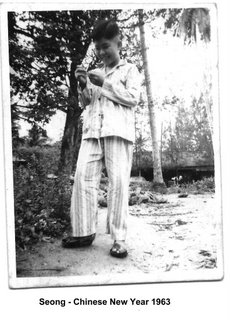Basically I have 2 reasons:
1) To reminisce about the ‘good old days’.
2) To educate the next generation about what life of their parents was like when they were young.
Firstly, I notice that people of my age group or older like to talk about the past. Whenever, my friends or relatives get together, at Chinese New Year gatherings, or dinners or even funerals, they like to exchange stories about the past. The reason of course, is that Singapore, especially the physical landscape, has changed a lot during our lifetime. There are very few places that have not changed during the past 30 years. Many of the places that I saw during my army days in the early 1970’s for example, like the kampongs in Jurong, Bt Batok, Marsiling, Hong Kah, Tampines and Ponggol have all gone. Therefore, I thought, a blog would be a useful place for people like us to network and exchange stories. It is no different from a kopi-tiam or a void deck really.
The second thing I notice is that our children seem to be very ignorant about life back in the old days; and about things of nature in general. Maybe life in Singapore is too fast-paced nowadays, and they have too many material distractions. Consequently, they miss out on many of the simple pleasures of life.

For myself, I make a special effort to tell my children about what life was like when we were kids; and the kind of things we enjoyed as kampong children. For example, I described to my son about how we caught fighting fish from the ponds in our village. He became very interested, and today he has taken up breeding fighting fish as a hobby. My children also keep many pets in our home, including a cockerel they fondly named Mellow. They are fortunate in a way, because my wife is a Malaysian. Our frequent trips back to her home town in Ipoh helped to expose my children to life in a less urban environment like Singapore.
 I bet you have never seen a chicken ride bicycle
I bet you have never seen a chicken ride bicycleBy the way, do you know what my son calls some of his friends….. ”乡上人“。That’s the opposite of a country bumpkin who is ignorant about modern things. So my second reason for starting this blog is to educate the “乡上“ young people of Singapore.
But what triggered off this project was something that happened during a recent trip to Myanmar. On my way back to the airport, I shared the hotel car with a Japanese man who was a frequent visitor to Singapore. During our conversation, I remarked that Yangon was very much like Singapore during the time when I was young. Many of the old British-style buildings resembled those in Singapore, and they have many crowded old buses like our Tay Koh Yat buses of the 60’s. He was surprised and said that Singapore must have changed a lot during the past few decades. Yes, and too fast, I replied. It was then that I decided I should start this blog.
I must say that I have been heartened and encouraged by the response that I have received so far. Many of the young people who visited my site actually enjoyed reading about all these old stuff. Initially, I was afraid that they may not like it. Some say that reading a first-person account was quite different from learning from the history books. They say they look forward to hearing more stories in my blog.
Another benefit of this project, which I did not realize before was that it helped to promote bonding between the 2 generations. Quite a few young people said that they want to ask their parents to read my articles. Apparently, their parents are quite afraid of the internet and IT; and so they hope to use this blog and my personal example to educate their parents.
I will try my best to live up to these young people’s expectations. But of course I cannot do it alone. I intend to get my siblings and friends to chip in. For example, my old friend, Simon Chu Chun Sing has contributed a few very interesting articles about Chinatown and promised to contribute some more. I have extended an invitation to other people of my generation to share their stories here, but so far I have not received any. I don’t know why. I hope it is because they too would like to start their own blogs; then I will have more blogs to read. Right now, other than Victor’s and Chris’ blog (see links section) the blogosphere does seem to be a rather lonely place for people my age.
In conclusion, I also want to remind myself that it is not healthy to live too much in the past. Like what the title of 尤雅’s song says, 往事只能回味. So I remind myself that our life on this planet is brief ( 短暂). We must also look to the future. That’s why I included a verse from the Old Testament of the Bible at the bottom of my blog which says (in Chinese);
“ 至于世人, 他的年日如草一样。
他发旺如野地的花,
经风一吹,便归无有。
他的原处也不再认识它。
但耶和华的慈爱归于敬畏他的人,
从亘古至永远。.”
Happy New Year everyone!

























